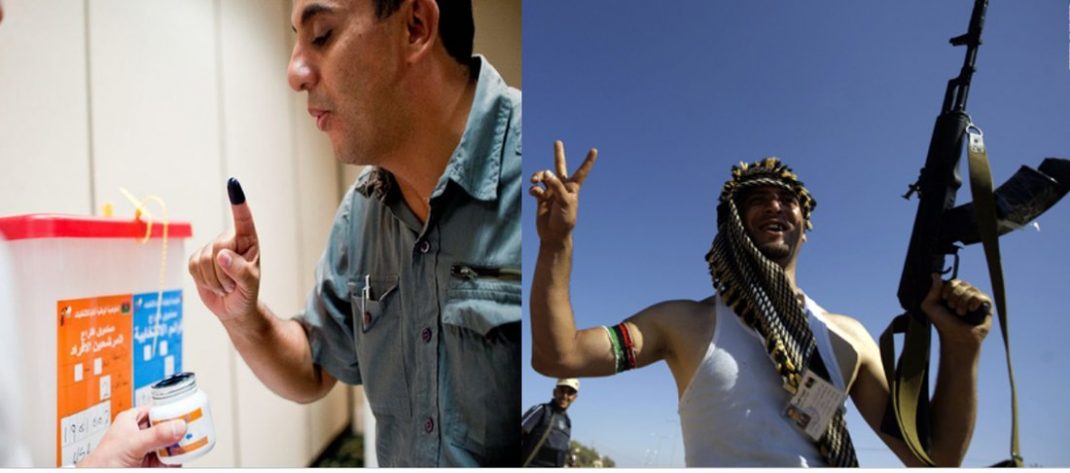By Dr. Omar Ashour
 The collective transformations from armed to unarmed activism are a process of relative change, in which an armed group can reverse its ideology, narratives, rhetoric, behaviour and/or organisational structure away from armed action, and towards unarmed political or social activism.
The collective transformations from armed to unarmed activism are a process of relative change, in which an armed group can reverse its ideology, narratives, rhetoric, behaviour and/or organisational structure away from armed action, and towards unarmed political or social activism.
PART TWO
The Empirical Dimension: Twenty-Six Case-Studies
In March 2010, an official conference was held in the Libyan capital of Tripoli with academics, western journalists and officials. It marked the release of the leaders of the Libyan Islamic Fighting Group (LIFG) in a “reconciliation” process led by Saif al-Islam Gaddafi, the then heir-apparent of Libya’s dictator, Gaddafi.
“Deradicalization” was a major component of the process.
The LIFG did not just abandon armed activism against the Gaddafi regime, but also produced 416-pages of thorough theological, ideological, instrumental and socio-psychological argumentations de-legitimating various forms of non-state armed activism – including national and international terrorism tactics.
Back then, the document served, and was celebrated, as a counter-narrative to the rhetoric and ideas of violent extremist groups, particularly Al Qaeda.
In August 2011, in the middle of an armed revolution, Abdul Hakim Belhaj, the former Emir of the LIFG spearheaded an attack on Bab al-Aziziya compound, Colonel Gaddafi’s headquarters.
That was more of a counteroffensive to the regime’s onslaught, than “reneging on the deal” or abandoning the transformation. Between February and August 2011, the political environment had no room for deradicalization or reconciliation.
And between March 2010 and February 2011, institutionalized mechanisms of non-violent conflict-resolution had not been introduced in Libya. Security sector reform processes, revisions of standard operating procedures (SOPs) in times of political crises, and a credible transitional justice process were unheard of.
In other words, a sustained transformation from armed to peaceful activism had little-to-no chance of surviving, despite significant investments in creating/initiating it.
This has not been just a Libyan story. Officers, soldiers and employees of Task Force 134 – the unit commanding all detention operations in Iraq, including Camp Bucca (the former home of Abu Baker al-Baghdadi) understand this well.
A “rehabilitation” program with a deradicalization component was introduced by the United States and the Iraqi government in Iraqi prisons in 2007. It had some initial effects and by 2008 about 10,000 prisoners were freed while the country was in a process of initial de-escalation.
By late 2010, almost all of the effects dissipated. Rather than a transformation towards unarmed, less-sectarian, constitutional and institutionalized politics, the Islamic State of Iraq and Sham (ISIS) was established in April 2013; on the ashes of both this program and the whole US-led de-escalation process.
As elaborated upon in the Symposium, this is not to conclude that transformation processes and “de-radicalisation” programs in the Arab World are destined to fail. The failure in Arab Countries is just a reminder of how critical the reforms on the macro-level are for sustaining the transformations, as exemplified by the European, Latin American, and African cases discussed below.
After all, processes of transformation to unarmed activism are critical to national reconciliation, social cohesion, the functioning of state institutions, human security and human rights. Hence, they are worth investing in and fighting for.
When pro-democracy changes happened on the macro-level and very basic political freedoms were briefly gained after the Arab Uprisings of 2010 and 2011, once-armed large groups upheld their transformation from armed to unarmed activism.
Organizations such as the Egyptian Islamic Group (IG), factions and individuals from the Egyptian al-Jihad organization, and the LIFG have not only turned into political parties, but also participated in elections, constitutional crafting and mainstream political compromises.
In 2011, the IG for example held internal elections, asked its members to fill out party registration forms, held rallies against sectarian violence and issued joint-statements with the Coptic Church of Assyut for promoting peaceful coexistence.
However, the stance on constitutional liberalism did not change much. For example, the IG still did not accept the right of specific minorities and women to run for presidency. And in general, ultraconservative regressive ideologies, such as Saudi Wahhabism, partly shape the worldview of the organization.
In Algeria, organisations such as the Islamic Salvation Army (AIS) and smaller groups has laid down arms since the late 1990s. Despite the selective (and relatively successful) socioeconomic reintegration of some of their leading commanders, these organizations were not allowed to participate in electoral politics.
Additionally, any research or investigative attempts into the security sectors’ procedures, behaviours and policies during the “national tragedy” and/or into a post-war transitional justice process are punishable by Algerian laws.
In comparison, European cases of collective transformations (or attempted ones) from armed to unarmed activism show stark differences in terms of initiation and sustainability of the processes, institutional maturity, strength and flexibility, both resilience and tolerance at societal and official levels, elite and leadership awareness, and reintegration capacities.
The cases of the Provisional Irish Republican Army (IRA) in the United Kingdom, the Basque Homeland and Liberty (ETA) in Spain, and Kurdistan Workers Party (PKK) in Turkey were discussed at length in the symposium.
In the United Kingdom, macro- and meso-level factors initiated the peace process and sustained the Good Friday agreement. They included the charismatic leadership, the British government’s innovative counter-terrorism strategy, the European Union peace funding (inducements), and the role of ex-combatants particularly at the community level (internal interactions).
In Spain, the continuous factional transformation of ETA – from the 1970s to 2017 – has shown the critical importance of meso-level factors (especially charismatic leadership), even when macro-level changes occur (such as democratic transition in Spain and the EU’s consistent support for transformations to unarmed politics).
Macro-level factors can certainly reduce the risk of a strong insurgent organisation, with significant local support. However, these elements do not guarantee a comprehensive transformation of an armed organisation to non-violent activism, without meso-level (organisational-level) factors.
In Turkey, the failure of the PKK to transform to unarmed politics, despite the presence of charismatic leaderships on both of the warring sides, and despite available opportunity structures, and the relatively free environment to participate in electoral and constitutional politics.
In a way, the PKK represents an outlier case, were the regional developments, external support, mutual distrust and perceived strategic gains by the guerrilla leaders from the armed path, all outweighed the estimated gains from transforming to compete in the ballot boxes.
Whereas levels of both democratic maturity and professional competence of the security establishments are quite high in Western Europe, Latin American democratic consolidation and security sector reforms are relatively recent. Hence, the lessons learned from Latin American successful (and failed) cases of transformations are highly relevant to the Arab World.
Latin America and the Caribbean region offered cases of transformation via different trajectories. Transformations after military defeats include the cases of the Tupamaros in Uruguay and, more generally, the armed Left-wing organisations in Chile, Argentina, and Brazil.
This is well-contrasted with the case of the Revolutionary Armed Forces of Colombia (FARC), where the transformation followed a draw, and the case of the Sandinistas in Nicaragua were the transformation into a political party happened after a decisive military victory.
The case-studies and experiences in Latin America reflected how a combination of the aforementioned meso- and macro-level variables (i.e. organisational level and state/interstate level) can both initiate and sustain collective transformations to unarmed activism, despite relatively limited wealth and resources in comparison to the Arab World.
Finally, African cases provided cases of successful transformations also under limited resources. Recent development in Ethiopia have shown a trajectory of transformation of former guerrilla organisations to coalition partners; a process that is still on-going with other armed groups.
A more successful transformation and a transition to democracy was in South Africa. It is a transformation via a draw and a hurting stalemate.
In this case, the charismatic leadership of Nelson Mandela was able to push the transformation and initiate peaceful negotiations, despite the capacity to use arms, internal resistance and even defections within the armed wing of the ANC (Spear of the Nation or MK), and the “war within the war” fought by the ANC and the Zulu Nationalist Inkatha movement.
Unlike the Arab cases (such as the IG in Egypt and LIFG in Libya), and some of the Latin American cases (such as the M-19 and the FARC in Colombia), the ANC in South Africa was quite successful in electoral politics and managed to win via ballots, not bullets.
Future Research: Scholarly Observations
From the above overview, a few scholarly observations can be deduced. In the Arabic literature, there are very limited academic analytical studies on transformations from armed to unarmed activism.
This is despite 12 out of 22 Arab regimes being either at war with components of their own societies, or at war with their Arab neighbours, and that the Arab region has the highest armed conflict ratio per capita in the world, and that the highest number of victims of armed conflict and political violence in the world reside in the Arab region.
A second observation is related to the English literature on collective transformations from armed to unarmed activism. The cross-regional, qualitative-comparative dimension is also rare and received relatively little attention.
There has been a considerable amount of work on the related but distinct topic reframed in “orthodox” Security Studies as “how terrorism ends.” It overviews a litany of possible reasons that an organization employing terror tactics may forgo political violence.
Nevertheless, this body of work neither explores what happens when an organization goes beyond armed activism and participates in peaceful activities, nor answers several of the above-mentioned critical research questions.
The state-centric (or status-quo-centric) assumptions in many of the “orthodox” Security Studies literature block deeper research into the phenomenon of collective transformation. The near-exclusive reliance on secondary sources has a similar effect.
A third observation is the limited interdisciplinary collaboration and approaches in this area of research. This is despite valuable contributions from disciplines and subfields as diverse as Security Studies, Political Science, Psychology, Sociology, History, Theology and Religious Studies, Peace Studies, Conflict Studies, Strategic Studies, Military Studies, and Media and Communications.
A fourth observation involves the relatively limited collaboration between scholars, official practitioners, and non-state leaders of these transformations.
The ACRPS symposium and its research outputs offered and will continue to offer the opportunity to collaborate, as it proved to be invaluable to academics, governmental officials and non-state leaders of the transformations, and has had an overall positive impact on the research agenda.
A fifth observation is the necessity of critical reviews of the already existing literature, with revisions and updates of the datasets.
Informed reflections on state-centric directions presented in the literature, coupled with critiques of replicated knowledge which decontextualizes or otherwise removes security crises from their historical contexts (ahistoricizing) are also necessary to move forward with this research agenda.
The same criticism should be applied to the over-reliance on secondary or unoriginal sources of knowledge. Scholars in this area of research should refrain from the singular focus on superficial, short-term “problem-solving” approaches, which has characterized some of the existing literature.
A final observation involves a few hypothesis-engendering research questions that still merit revisiting and further research investigation.
Most of the works concentrated on how such transformations happen and why they happen, with a focus on either a single case-study or on a comparative approach in one particular region. However, a differentiation between initiating the transitions and sustaining them, as well as the conditions for their endurance merit more investigation.
Also, the different trajectories taken after moving away from armed action has also been underexplored.
…
continues in part 3
***
Omar Ashour – Associate Professor of Security Studies and Middle East Politics. Martial arts former champ, among other stuff. Views mine.
_____________________





